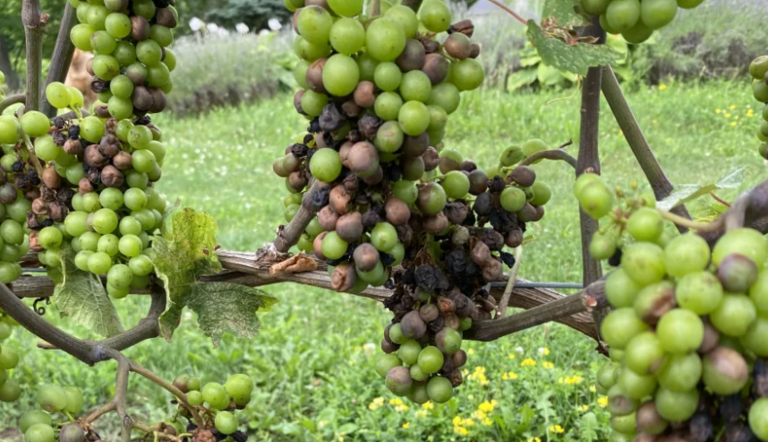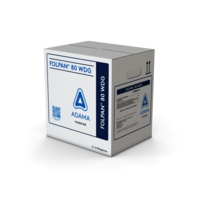
Black rot of Grapes
Guignardia bidwellii
Pest Profile
07 juillet, 2025
3 min read

(Photo Credit: ONFruit)
Description and life cycle:
- A fungal disease that can infect both the fruit and green vegetative tissues (leaves, shoots, tendrils)
- Infection is favoured by high humidity and warmth early in the season; infection on the vegetative tissues can occur starting in the late spring and fruit infection can occur shortly after flowering
- Reddish-brown lesions form on the upper surface of new leaves, which can grow and merge. As the disease develops the lesions will be ringed by black pycnidia which can release new spores
- Infections on the fruit begins as a pale circle with a darker outside ring. The disease develops quickly and in the matter of a few days can colonize the entire berry, leaving it black and hardened (mummified)
- Black rot overwinters in the canes and plant residues, including mummified berries. During spring/summer rain events the disease will release windborne spores that can infect nearby grapes. Early infections can re-release spores causing new, later season infections. The disease overwinters on infected tissues (most problematic being mummified fruits), which await the spring to repeat the cycle
Crop Damage:
- Depending on severity of infection, and timing, losses of fruit yield can be between 5 – 80% (losses are most severe with later infections)
- Damage to the vegetative tissues isn’t as economically impactful as fruit infections, severe infections can weaken the vines
Management Strategies:
- No thresholds exist for Black rot, management steps should be taken prior to infection
- Manage the vineyard to ensure good air flow (minimize leaf wetness time) and maximize distance between the fruit/green vegetation and the ground
- Ensure all infected material (mummified fruits in particular) are removed from the field prior to bud break in the spring; physical remove the material or cultivate it into the soil
- Numerous fungicidal options exist, including both preventative and ‘curative’ options
Control Strategies from ADAMA:
- FOLPAN® 80 WDG (group M04) is a strong preventative product for Black rot in grapes
- Apply 1.25 kg/ha of FOLPAN® 80 WDG, targeting 1000L/ha spray volume
- Application timing can begin just before bloom, with a maximum of 4 total applications per season, with a minimal retreatment interval of 10 days
- FOLPAN® 80 WDG also provides activity on Dead arm, Downy mildew and Powdery mildew (for Powdery mildew control must be tank mix with Kumulus DF). Refer to the label for additional information
Referenced Literature:
Missouri Botanical Garden. Black rot of grapes. https://www.missouribotanicalgarden.org/gardens-gardening/your-garden/help-for-the-home-gardener/advice-tips-resources/insects-pests-and-problems/diseases/fruit-spots/black-rot-of-grapes#:~:text=Black%20rot%2C%20caused%20by%20the,effect%20is%20to%20the%20fruit.
ONfruit. Why is black rot so bad in some Ontario vineyards in 2024? https://onfruit.ca/2024/07/26/why-is-black-rot-so-bad-in-some-ontario-vineyards-in-2024/
PennState Extension. Grape Disease – Black rot. https://extension.psu.edu/grape-disease-black-rot
